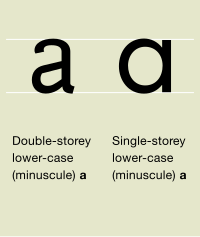Uzanto:Atmark-chan/provejo/artikloj
A[redakti | redakti fonton]
Historio[redakti | redakti fonton]
(Tradukantas de en:A#History)
| Egipta | Fenica Alef |
Semida |
Greka Alfo |
Etruska A |
Roman/Cyrillic A |
Boeotian 800–700 BC |
Greek Uncial |
Latin 300 AD Uncial | |||
|---|---|---|---|---|---|---|---|---|---|---|---|

|
|||||||||||
|
|||||||||||
La plej flua certa prapatro de "A" estas Alef, la unua litero de la Fenica alfabeto,[1] which consisted entirely of consonants (for that reason, it is also called an abjad to distinguish it from a true alphabet). In turn, the ancestor of aleph may have been a pictogram of an ox head in proto-Sinaitic script[2] influenced by Egyptian hieroglyphs, styled as a triangular head with two horns extended.
By 1600 BC, the Phoenician alphabet letter had a linear form that served as the base for some later forms. Its name is thought to have corresponded closely to the Paleo-Hebrew or Arabic aleph.
 Blackletter A |
Uncial A |
Another Blackletter A |
 Modern Roman A |
 Modern Italic A |
 Modern script A |
When the ancient Greeks adopted the alphabet, they had no use for a letter to represent the glottal stop—the consonant sound that the letter denoted in Phoenician and other Semitic languages, and that was the first phoneme of the Phoenician pronunciation of the letter—so they used their version of the sign to represent the vowel /a/, and called it by the similar name of alpha. In the earliest Greek inscriptions after the Greek Dark Ages, dating to the 8th century BC, the letter rests upon its side, but in the Greek alphabet of later times it generally resembles the modern capital letter, although many local varieties can be distinguished by the shortening of one leg, or by the angle at which the cross line is set.
The Etruscans brought the Greek alphabet to their civilization in the Italian Peninsula and left the letter unchanged. The Romans later adopted the Etruscan alphabet to write the Latin language, and the resulting letter was preserved in the Latin alphabet that would come to be used to write many languages, including English.
Typographic variants[redakti | redakti fonton]

During Roman times, there were many variant forms of the letter "A". First was the monumental or lapidary style, which was used when inscribing on stone or other "permanent" media. There was also a cursive style used for everyday or utilitarian writing, which was done on more perishable surfaces. Due to the "perishable" nature of these surfaces, there are not as many examples of this style as there are of the monumental, but there are still many surviving examples of different types of cursive, such as majuscule cursive, minuscule cursive, and semicursive minuscule. Variants also existed that were intermediate between the monumental and cursive styles. The known variants include the early semi-uncial, the uncial, and the later semi-uncial.[3]

At the end of the Roman Empire (5th century AD), several variants of the cursive minuscule developed through Western Europe. Among these were the semicursive minuscule of Italy, the Merovingian script in France, the Visigothic script in Spain, and the Insular or Anglo-Irish semi-uncial or Anglo-Saxon majuscule of Great Britain. By the 9th century, the Caroline script, which was very similar to the present-day form, was the principal form used in book-making, before the advent of the printing press. This form was derived through a combining of prior forms.[3]
15th-century Italy saw the formation of the two main variants that are known today. These variants, the Italic and Roman forms, were derived from the Caroline Script version. The Italic form, also called script a, is used in most current handwriting and consists of a circle and vertical stroke. This slowly developed from the fifth-century form resembling the Greek letter tau in the hands of medieval Irish and English writers.[1] The Roman form is used in most printed material; it consists of a small loop with an arc over it ("a").[3] Both derive from the majuscule (capital) form. In Greek handwriting, it was common to join the left leg and horizontal stroke into a single loop, as demonstrated by the uncial version shown. Many fonts then made the right leg vertical. In some of these, the serif that began the right leg stroke developed into an arc, resulting in the printed form, while in others it was dropped, resulting in the modern handwritten form. Graphic designers refer to the Italic and Roman forms as "single decker a" and "double decker a" respectively.
Italic type is commonly used to mark emphasis or more generally to distinguish one part of a text from the rest (set in Roman type). There are some other cases aside from italic type where script a ("ɑ"), also called Latin alpha, is used in contrast with Latin "a" (such as in the International Phonetic Alphabet).
Notoj[redakti | redakti fonton]
- ↑ 1,0 1,1 Hoiberg 2010, p. 1
- ↑ Hall-Quest 1997, p. 1
- ↑ 3,0 3,1 3,2 Diringer 2000, p. 1
Referencoj[redakti | redakti fonton]
(Tradukantas de en:A#References)
- Anon (2004) English Letter Frequency. Math Explorer's Club. Cornell University. Arkivita el la originalo je 22 April 2014. Alirita 28 May 2014.
- Anon (2006) Percentages of Letter frequencies per Thousand words. Arkivita el la originalo je 25 January 2007. Alirita 11 May 2015.
- (2010) “A versus F: The effects of implicit letter priming on cognitive performance”, British Journal of Educational Psychology 80 (1), p. 99–119. doi:10.1348/000709909X466479.
- “A”, Encyclopedia Americana.
- “A”, Academic American Encyclopedia.
- “A”, Collier's Encyclopedia.
- “A”, Encyclopædia Britannica.
- (September 1974) “The Early Diffusion of the Alphabet”, The Biblical Archaeologist 37 (3), p. 54–68. doi:10.2307/3210965.
- “A”, The Oxford English Dictionary.
